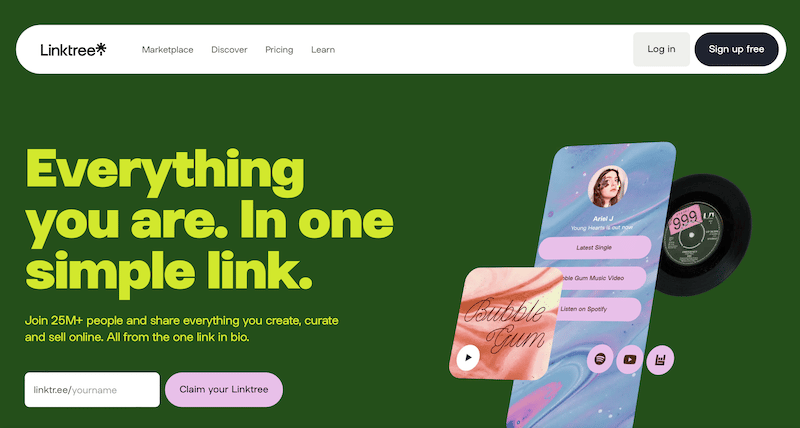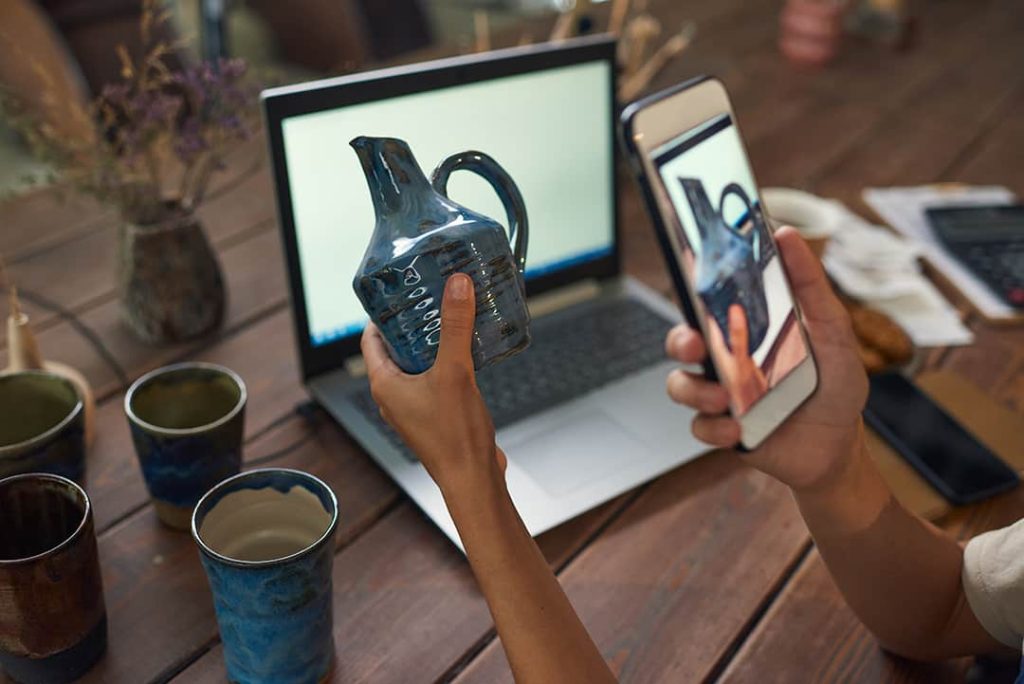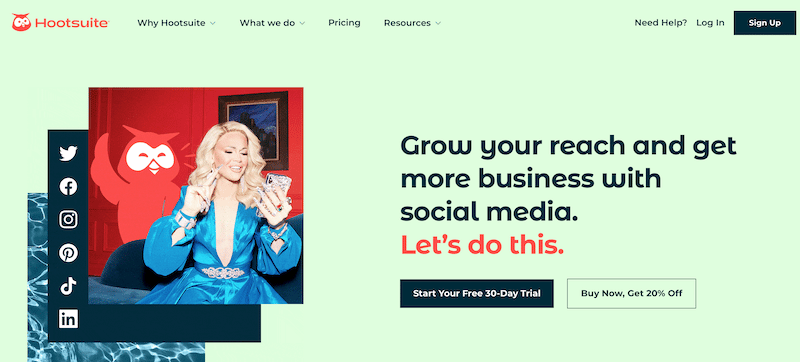When you think about how the most prolific artists market their art, what comes to mind? Perhaps you imagine a well-heeled creative strutting hurriedly through the streets of Chelsea on their way to schmooze at a top gallery. Or maybe you think about a hip young illustrator visiting a major advertising agency, their painstakingly curated portfolio ready to meet a swarm of art directors.
Art marketing is a critical piece of the puzzle for any artist who wants to drum up awareness and interest, and in this day and age, social media is an unignorable influence. Equipped with the power to help you connect with collaborators, win over clients and collectors, and sell your work, social media builds relationships and community while helping you cement a professional reputation.
With so many platforms and a fast-growing number of creative apps hitting the market, it’s easier than ever to connect with the right audience and:
- Build a global following
- Network with other creatives
- Grow relationships
- Connect with supporters and fans
- Develop your brand on your terms
But like most things, you want to be sure that social media is used in moderation: sadly, it can also transform into a place of frustration and isolation. But that’s where we come in! Let’s take a look at some of the best practices when it comes to marketing your art on social media so you can strategize and promote without spinning your wheels.
What is the best social media platform for marketing art?
Let’s get this out of the way: there’s no such thing as “best” when it comes to marketing artwork on social media. However, there is a best for you. Think about where you enjoy spending your time online – do you love to scroll through Instagram and interact with a robust following? Or are you active in creative spaces on Reddit? What about art marketing on Pinterest? How you spend your time reveals a lot about how you should strategize.
You also want to think critically about where you get the most interaction – remember, your time is limited, and the last thing you want to do is waste time and energy. Ask yourself where your audience is before committing to a social media strategy, and remember to take the time to explore what’s out there:
These are some of the most popular social media networks to look into for artists and creatives:
With so many options, it can feel overwhelming—just allow yourself a chance to explore and figure out what’s a good fit. At the end of the day, you’ll need to choose a small selection so you can commit to being a constant presence (one of the great not-so-well-kept secrets of social media). Engagement takes two, and you need to be present if the goal is to build your audience and brand.
However, we do have one tip: the reality is that many visual artists prefer Instagram, perhaps in part because it remains the most popular visual platform. As we dive further into our discussion about how to supercharge your art marketing efforts, we encourage you to remember that, while most of these suggestions are universal, some are particularly relevant when using Instagram.
Optimize your Social Media Profiles
Art marketing experts often suggest that you establish continuity throughout all of your profiles. This means that your account name should be the same (or similar, if a specific username is unavailable) and that any important links, like to your portfolio, be consistent throughout.
When it comes to Instagram, you’ll want to maximize your 150-character bio. Tell potential fans who you are and what your work is about, and remember that this is the only place where you can post an active link—you’ll need to make it count. At the very least, you’ll want to link to a current portfolio, or if you’re interested in drawing attention to something more specific, like a recently published profile, that’s also an option.
Two hot tips: with only 150 characters, you may want to use a tool like Bitly to keep your URLs short and sweet. You can also take advantage of link-in-bio tools like Linktree to maximize your link and direct users to a menu of options. Just be sure that things are user-friendly, straightforward, and easy to navigate. (What should you write? See “The Ultimate Guide to Writing an Artist Statement.“)

Linktree is one of the most popular and useful link-in-bio tools for Instagram.
Keep it connected
When it comes to art marketing, you need to spoon feed your audience—and that means making your platforms easy to find. Do you have a website? Be sure to link to your social media accounts to give people a chance to further connect. You can even maximize your emails by including a link in your signature.
You might also want to consider using programs like AddThis to easily add social icons and share buttons, which can increase audience engagement, boost your brand, and help generate an enthusiastic audience that you can more easily nurture.
Art Marketing Means Consistency
It can be hard to pinpoint exactly what triggers social media algorithms, but there are two things that are predictably favored: consistency and engagement. This translates to committing to posting regularly, regardless of whether or not you have new work, and keeping your audience engaged. Instagram favors consistency, so if you find yourself in a place where you can’t share something new, consider posting about your creative process, what you find interesting, or even give a shoutout to other creators that you find inspiring—they may return the favor. Either way, frequent posts with good engagement lead to being prioritized in your follower’s feeds.

Create a consistent posting schedule to build audience engagement.
Art Marketing Also Means Quality and Authenticity
Another big reason why consistency counts? It helps followers connect with you as a real person, which means that when it’s time to push an upcoming show or sales event, your messaging reads as less “sales-y”. The age-old concept of quality versus quantity also holds true: if you’re struggling to keep up with your new posting schedule, consider pulling back so you can create quality content while sticking to your plan.
Don’t get preoccupied with your follower count
While a large number of followers can feel (and look) good, don’t let it impact your relationship with the platform. Quality is more important than quantity, and followers who genuinely care about your vision and voice are going to engage with your content naturally. Focus on strengthening the connections you’ve already made: your work may not be for everyone, but the audience you already have is already invested in you. Take advantage and engage them in a conversation:
- Leave thoughtful comments on other people’s posts. Bonus points if they’re more substantial than an emoji!
- Write brief yet personal responses to comments on your own posts. Other followers will take notice and feel inspired to engage.
- Promote other artists on your feed and focus on symbiotic relationships with people that love what you’re doing. Send them a DM, follow, and like back—you want to equal the enthusiasm of your high-engagement followers’ content.
- Use every comment as an opportunity to gain or keep a follower.
Smart Art Marketing Means Posting at the Right Time
The reason you’re marketing your artwork is to expose people to your craft, which means that timing is everything. Make sure you post new content when your audience is actually online. Just do a quick internet search to get a sense of the best posting times for your preferred platforms: for example, many Instagram users check-in between 7-8 am on weekdays or just before they head off to work. Considering that Instagram’s algorithm considers “recency” as a major ranking signal, you’ll naturally improve your organic reach.

Hootsuite is a great platform for gathering social media intelligence, like the best time to post. It can also schedule your posts on various platforms.
Level up with a business account
Establishing a business account is the secret to great marketing, and actually quite easy. Better yet, it has the added benefit of offering accurate analytics about your followers, which means you can make a smarter, more informed plan. Using their detailed reports, you can identify your most successful posts through various metrics like:
- Awareness, or posts that have high impressions
- Engagement, or posts that earned a greater engagement rate
- Sales/Traffic, or posts that attracted a lot of clicks
Using this data, take a look at the days and times you posted your most successful content. What patterns begin to emerge? Use this information to optimize your social media strategy and watch your content take off.
Art marketing relies on high-quality images
It may seem obvious, but high-quality content is everything when it comes to marketing your art. You might even think of social media as a trade publication: what would gain the attention of the people in your industry? Will the image and copy stand out and tell a compelling story? While paying attention to when you’re posting is important, you don’t want to meet your audience with a post that underwhelms, bores, or offends. You’ve worked hard to establish your practice: honor it by paying attention to image quality, good cropping, pithy captions, and avoid large watermarks that obscure.
Remember the 80/20 rule
Remember our previous conversation about “authenticity”? The 80/20 rule is an extension of that and one that self-promoters across all industries rely on. Quite simply, 80% of your content should share compelling information, while 20% is dedicated to promoting your work. Believe it or not, successful art marketing isn’t always about selling: it will actually benefit you to share about your process, what inspires you, exciting upcoming projects, or even important lessons you’ve learned or challenges you’ve overcome.
Art marketing means being yourself
Don’t underestimate the power of letting your followers into your world. By letting them have a genuine look into your life, you’ll form a powerful connection that means they’ll be personally invested in your work. Do you laugh about your cramped studio in the corner of a tiny apartment? Embrace it and share: it’s relatable and inspiring that you’re able to make it work. Or do you have a four-legged studio manager that, while cute, doesn’t do much more than snooze in the corner? Why not share a snap—it’s an honest look into your life, and one that people will love.
_______
Marketing art online is an influential and cost-effective way to get yourself out there, regardless of your intentions. Millions of people are quite literally at your fingertips, and finding the right audience means gaining access to new collectors, identifying new opportunities like jobs or residencies, and sharing success stories with your legions of fans. With just a little thoughtful strategizing and effort, you’ll quickly see that this invaluable tool can grant you access to bold new frontiers. See you online!
How have you used social media to promote yourself as an artist? What advice do you have for growing your audience and staying authentic online? Comment below!
